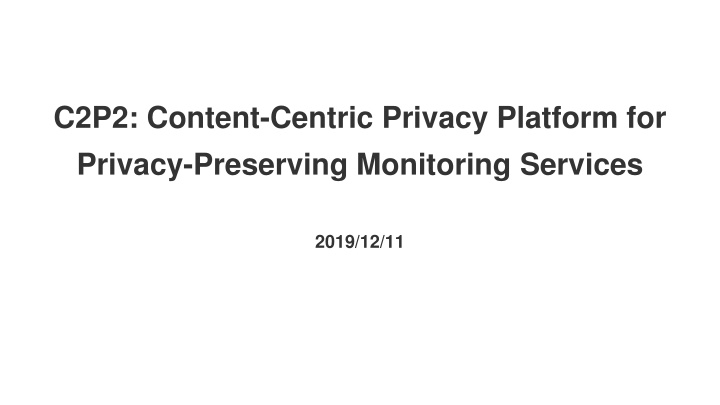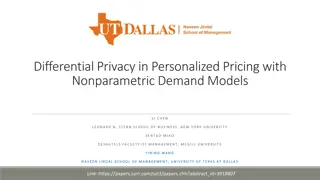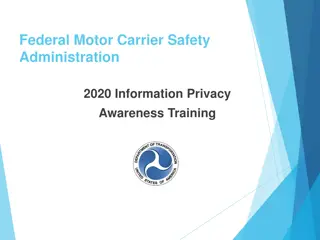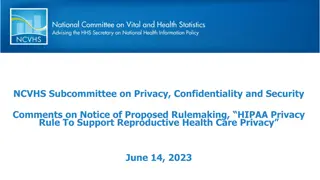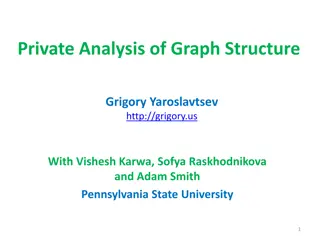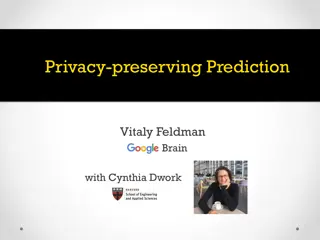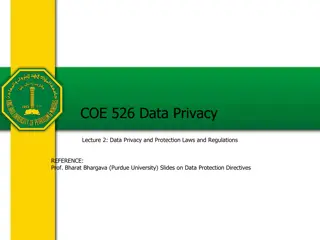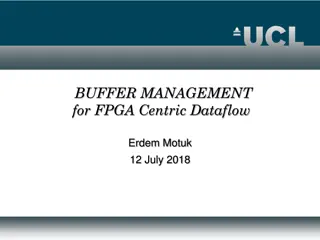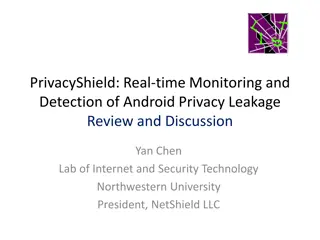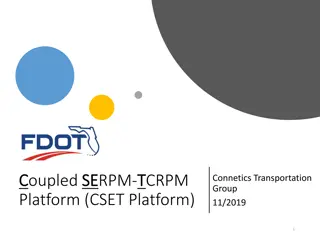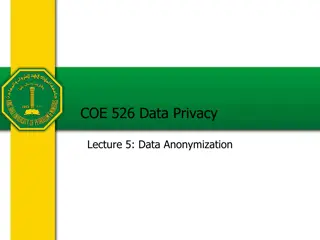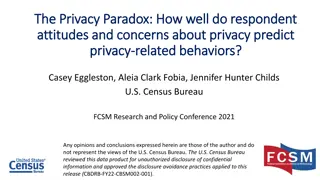C2P2: Content-Centric Privacy Platform for Privacy-Preserving Monitoring
This content discusses the C2P2 system designed to enhance privacy in monitoring services by reducing dependency on cloud servers. Through a series of models and steps, C2P2 addresses vulnerabilities such as single point attacks and privacy leakage. It introduces an Information Centric Network-based communication approach for session-less, anonymous, and efficient data routing.
Download Presentation

Please find below an Image/Link to download the presentation.
The content on the website is provided AS IS for your information and personal use only. It may not be sold, licensed, or shared on other websites without obtaining consent from the author.If you encounter any issues during the download, it is possible that the publisher has removed the file from their server.
You are allowed to download the files provided on this website for personal or commercial use, subject to the condition that they are used lawfully. All files are the property of their respective owners.
The content on the website is provided AS IS for your information and personal use only. It may not be sold, licensed, or shared on other websites without obtaining consent from the author.
E N D
Presentation Transcript
C2P2: Content-Centric Privacy Platform for Privacy-Preserving Monitoring Services 2019/12/11
Introduction Cloud servers are vulnerable at single point attack and cause privacy leakage. Malicious (or honest but curious) service provider is also a threat to privacy. Homomorphic encryption suffers from its limitation and overhead. They propose C2P2 to reduce the dependency to the cloud server.
Models A. System Models Consists of a trusted party authority (TPA) and surveillance cameras. System provides service of finding a target object. User submit query to the system, and camera will return the matching result.
Models B. W privacy model Consists of Who, Which, What. The relationship of any two elements leads to privacy leak. C. Threat model Eavesdrop attack Single point attack
C2P2 1) Consists of three steps: (i) Registration (ii) Classification model generation (iii) Camera execution
C2P2 i. Registration
C2P2 ii. Classification model generation
C2P2 iii. Camera execution
C2P2: ICN-based communication Information centric network has properties that satisfied the needs of C2P2 session-less communication anonymous in-network caching traffic reduction name-based routing multicasting Interest packet Data packet request service
C2P2: ICN-based communication Naming scheme Domain Location : The geographical domain location in C2P2 Network Function : Action or content type Information : Parameter for the network funciton Example: search request /NYC/CentralPark/ f:searching/#model=5e678f3255,#date=2019-01-21 Example: camera acquire classification model /TPA/ClassificationModel/#model= 5e678f3255
C2P2: ICN-based communication Three strategies when facing multiple next hops: a. Regular NDN forwarding strategy (RF): Choose only one next hop by metric such as RTT, weight, random etc. b. Flooding forwarding scheme (FF): Sending all next hops. c. Keyword-based forwarding strategy (KF): a tag-based RF. A gateway parses tags in the information component and execute the correspond action, collecting the results and sending back the results with one data packet in RF.
Privacy Analysis Privacy loss ratio: Where c is set of two edge without loop Example Probability =
Privacy Analysis Cloud: Eavesdropping: Knowing who or "where" independently, no relationship is revealed. Single point attack: Cameras: Only know "where", but no clues of who and what". Cloud server: All information is stored, hence the loss is 100% C2P2: Eavesdropping: Can learn which classification models but no clue of what . Can know the set of cameras S by tracing all requests from user, so the Prob. of finding where is 1/|S |. Overall, what information cannot acquired. Single point attack: TPA: Assuming q as Prob. of what been inferred correctly, so in the TPA, Pu t = Pt u = q, and Pt l = 1/(|S | 1) (# of cameras). R = q / (|S | 1). Cameras: Requests contain S , so Pl u = 1/(|S | 1), and inference Prob. of the target image Pl t = q, so R = q / (|S | 1). Gateway: Knows where , but knows nothing about what .
Performance Evaluation Operational cost: Image recognition cost: image size: 4.38 MB matching time: 0.219 ms Cryptography cost: setup: 0.42 ms / 100 subs. decrypt time: 113 ms for 10MB
Performance Evaluation Communication cost: assume classifier size 40MB FPS = 30 Image size = 12.4MB/s(1080p) Two sceanarios: 5.9 million cameras with 1.2 trillion requests. (2% cost than cloud) 100 CCTV with 50 requests each day (0.01% cost than cloud) Classifier model size Image file size Frequency that camera collects classifier Numbers of camera Cost-effective constraints :
Conclusion To prevent single point attack at cloud server and malicious service provider This paper proposes C2P2, a ICN based monitoring services to preserve W privacy in a distributive manner
